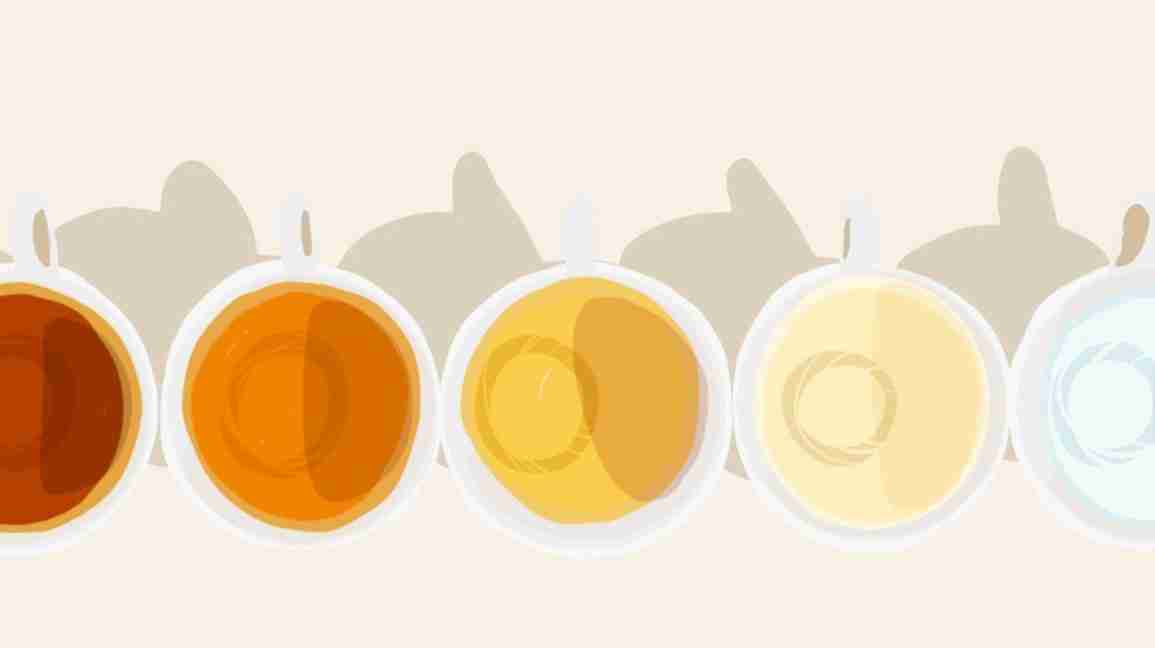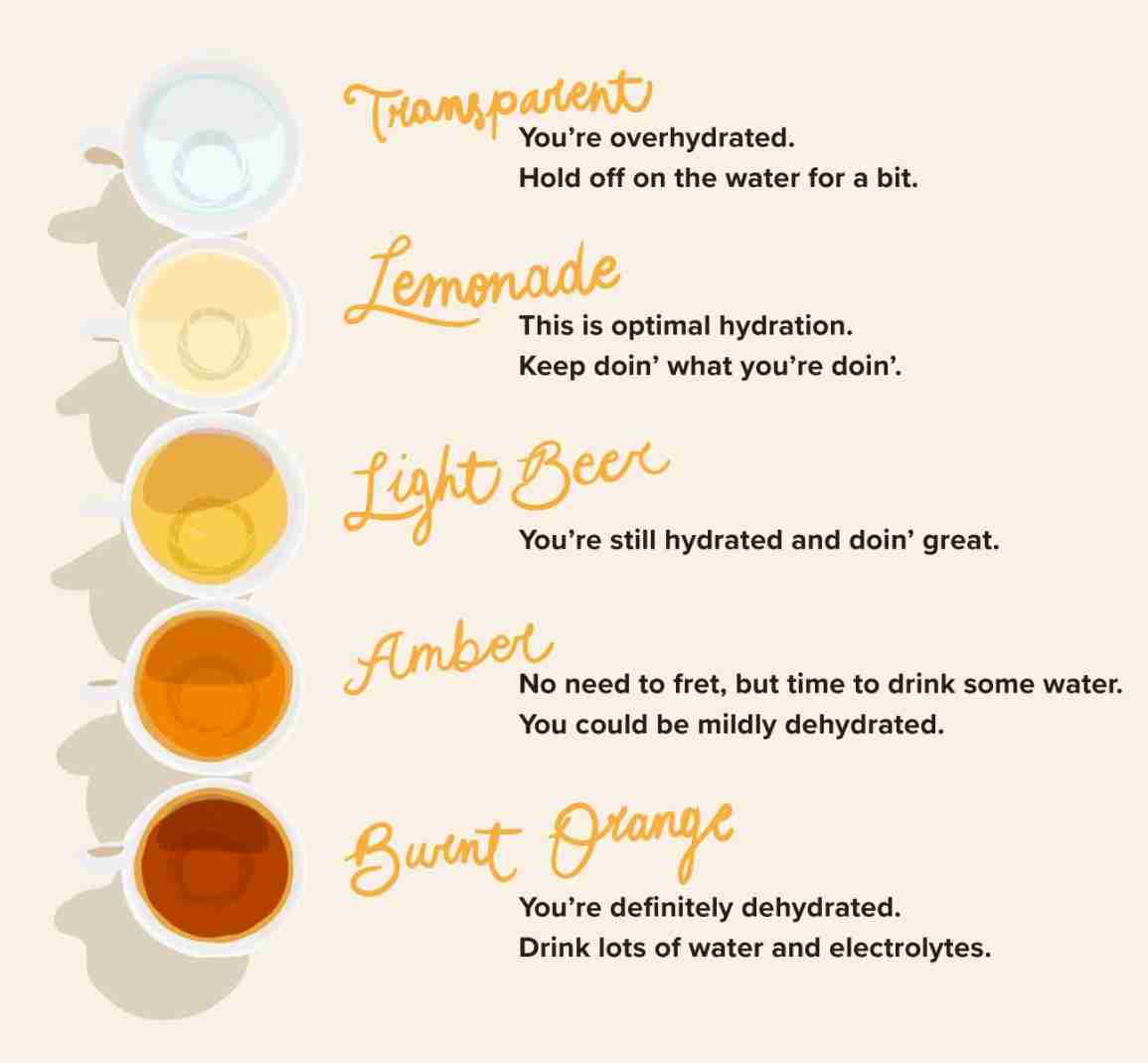Since hydration supports loads of bodily functions — affecting everything from
The good news is you don’t have to get your hands dirty peeing in a cup. You can assess the color simply by peeking into the toilet bowl after you pee. (Don’t worry if the color gets a little diluted by the toilet water. It’s still a perfectly useful gauge.)
You’ve probably noticed the color changes on a daily, often hourly, basis. So, what’s healthy and what should be addressed? We put together this helpful pee color chart so you can stop wondering.
Read on to learn why these colors are happening.
It’s important to drink enough water every day, but it’s possible to overdo it. If your pee is totally transparent and missing a yellow hue, you’re probably drinking more than the recommended amount of water.
Also, if peeing has become your full-time job, that’s another sign you’re hydrating a bit too hard. For the average adult, taking 4 to 10 pee trips in a 24-hour period is considered normal.
The reason you want to avoid overhydrating is because an excess of water dilutes your body’s electrolyte content. While rare, this can lead to water intoxication.
But the vast majority of us don’t have to worry about that level of overhydration. Generally speaking, when you’re overhydrated, limit yourself to small sips of water until your pee regains a yellow tint.
Pee ranging from lemonade-colored to a brighter shade like light beer means you’re solidly hydrated. We like to consider this area of the pee spectrum our #peegoals. (That’s right, go ahead and boast about it!)
Drinking water is the most obvious way to stay hydrated. But did you know eating fruits and vegetables is also a great source of water?
Fruits and veggies great for hydration
- tomatoes
- cucumbers
- strawberries
- cabbage
- zucchini
- lettuce
- melons
When pee looks like amber or a darker shade of blond, it’s probably time to drink some water. Although this part of the spectrum doesn’t signify a dangerous level of dehydration, you could be headed in that direction.
When your body loses more water than it takes in, it starts hanging onto the water it does have. With less water to dilute them, the naturally occurring minerals and chemicals in your pee become more concentrated and deeper in color.
If your pee is any shade of brown or dark orange, it’s time to pay attention, because you’re likely severely dehydrated.
Vomiting, diarrhea, and fever cause the body to lose water quickly and are common causes of dehydration. Luckily, most healthy adults can easily rehydrate by consistently drinking lots of water and fluids high in electrolytes.
Keep in mind that although bottled and tap water contain trace amounts of electrolytes, you may need something with a higher concentration, like Gatorade or a homemade tonic to adequately restore your body’s electrolyte balance.
For kids dealing with dehydration from vomiting and diarrhea, the Mayo Clinic recommends treating with an oral over-the-counter rehydration solution like Pedialyte.
Tips for staying hydrated
- Carry a reusable water bottle.
- Limit caffeine and alcohol intake.
- Drinks lots of water before you work out.
- Limit foods that are overly salty or sugary.
- Add lemon to your water to make it more appetizing.
It’s also possible something you recently ate is causing the brown pee. Some foods known to cause brown urine include:
- aloe
- fava beans
- food coloring
- rhubarb
Medical conditions associated with brown urine include:
- kidney disease
- liver disease
- porphyria, a rare genetic blood disorder
We expect our pee to be some kind of yellow. So, when we glance into the toilet and see any other color, it can be momentarily panic-inducing.
Before jumping to any wild conclusions about why your toilet bowl looks like a bowl of Fruity Pebbles, take a second to think about any new foods you’ve eaten or medications you’ve taken.
| Color | Medication-related cause | Food-related cause | Medical condition-related cause |
| wine red to pink | senna (Ex-Lax), chlorpromazine (Thorazine), thioridazine (Mellaril) | blackberries, beets, and rhubarb | infection of the prostate, bladder, or kidney; tumors or internal injury |
| orange peel to copper | rifampin (Rifadin), warfarin (Coumadin), phenazopyridine (Pyridium) | carrots or carrot juice | dehydration and problems with the liver or bile duct |
| blue to green and everything in between | amitriptyline, indomethacin (Indocin), cimetidine (Tagamet), and promethazine (Phenergan); also methylene blue and propofol (although these are rarely used outside of the hospital setting) | asparagus and food coloring | urinary tract infection (UTI) caused by |
| lavender to indigo | not applicable | food coloring | UTI caused by P. aeruginosa bacteria, Hartnup disease, |
| cloudy to opaque | not applicable | anchovies, herring, red meat, an excessive amount of milk | dehydration, a sexually transmitted infection (STI), UTI, kidney stones, vaginitis, and prostatitis |
Other symptoms that point to more serious conditions:
- fever
- nausea
- vomiting
- abdominal pain
- frequent urge to pee
Hesitation, uncertainty, and a stream of abnormal colors that can’t be attributed to foods you’ve recently eaten or medications you use are good reasons to see a doctor.
However, experts emphasize that if your urine is very dark or orange, make an appointment sooner than later, as a malfunctioning liver can make this happen.
Also a good reason to see a doctor? Accompanying smells and symptoms, such as:
- a pungent or fishy odor
- abdominal pain
- dizziness or confusion
- fever
Compound symptoms are often a sign that something deeper is going on in the body.
The current daily recommendation is approximately 9 cups for women and 13 for men. But keep in mind this is just a general guideline.
Factors like age, if you’re pregnant or breastfeeding, how hot the weather is, and your level of physical activity all have an impact on how much water is a healthy amount for you.
Q:
Is drinking when you’re thirsty a reliable way to stay hydrated?
A:
If you’re waiting to drink until you’re thirsty, you may be missing the mark. Having a refillable water bottle that’s always handy is a good way to ensure you’re getting enough water. You can remind yourself to take a drink between tasks or at other intervals, like commercial breaks or a new episode of a show. If you’re somewhere where it’s very hot or dry, or you’re breastfeeding or doing a lot of physical activities, make sure to squeeze in a little more.
Carissa Stephens, RN, CCRN, CPNAnswers represent the opinions of our medical experts. All content is strictly informational and should not be considered medical advice.



